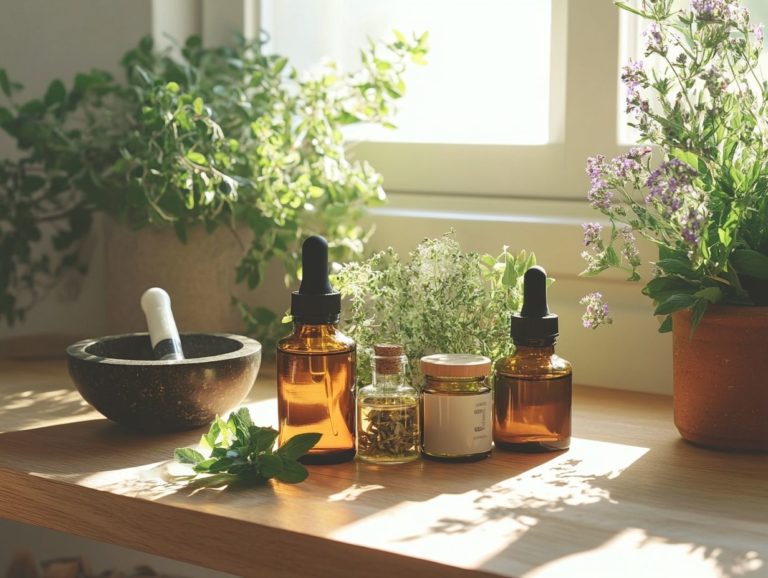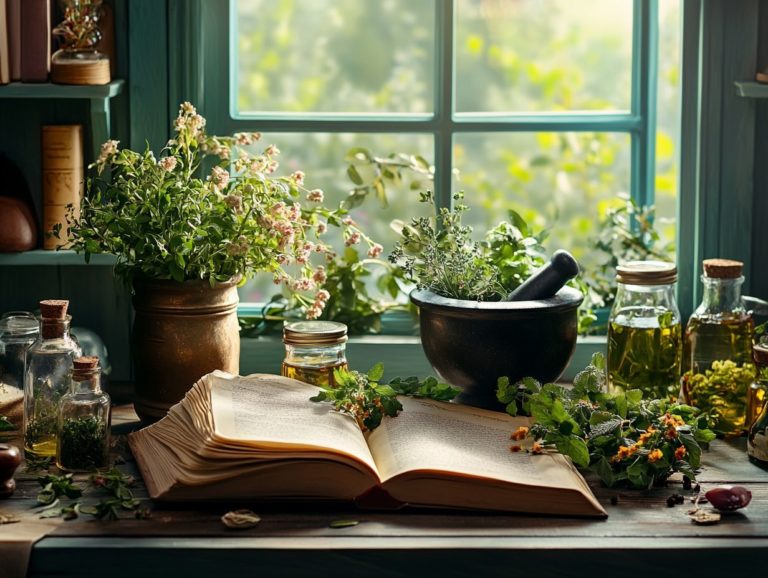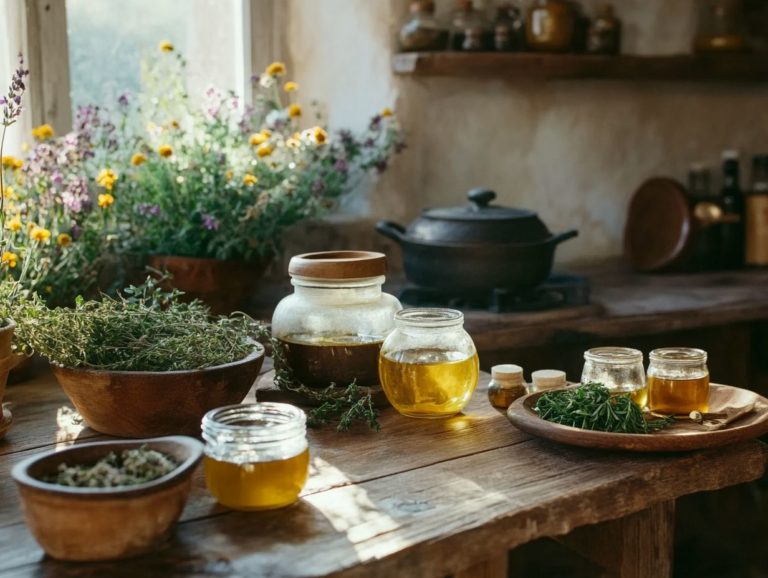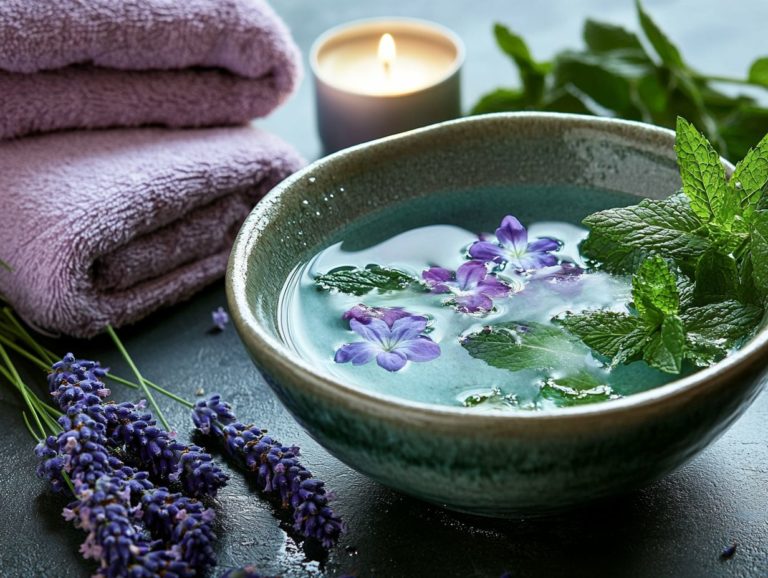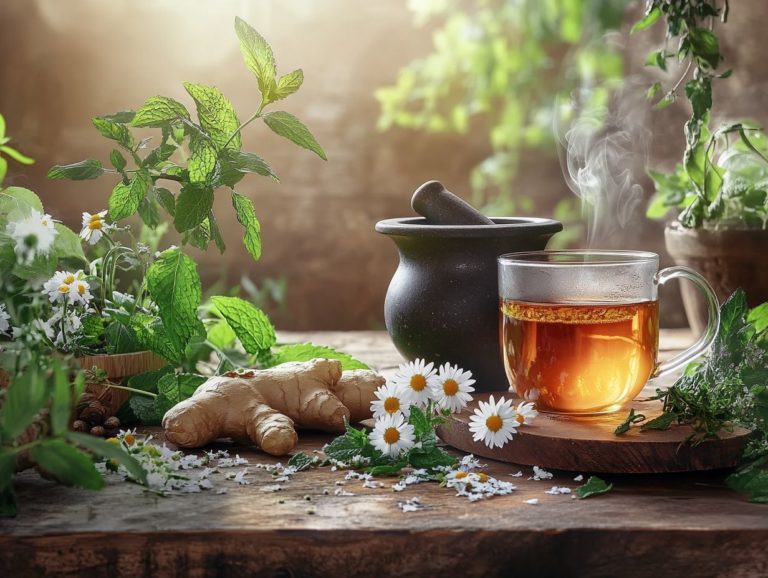Herbal Oils: How to Make Your Own Blends
Herbal oils have surged in popularity due to their many benefits, ranging from soothing skin irritations to elevating your mood.
By keeping these tips in mind, you can ensure that your experience is both safe and fruitful in crafting remarkable herbal oils.
This guide is designed to provide you with everything you need to craft unique herbal oil blends. You will uncover essential tools, the ideal carrier oils, such as jojoba oil and olive oil, and the best herbs tailored to achieve your desired effects.
You will also find DIY recipes, storage tips, and important safety precautions to ensure you harness the full potential of your creations.
Are you excited to start this journey?
Contents
- Key Takeaways:
- 1. Understanding the Benefits of Herbal Oils
- 2. Essential Tools and Ingredients for Making Herbal Oils
- 3. Choosing the Right Carrier Oil for Your Blend
- 4. Selecting the Best Herbs for Your Desired Results
- 5. Step-by-Step Guide to Making Your Own Herbal Oil Blend
- 6. Tips for Storing and Preserving Your Herbal Oils
- 7. Different Methods of Using Herbal Oils
- 8. Safety Precautions to Keep in Mind
- 9. Common Mistakes to Avoid When Making Herbal Oils
- 10. How to Incorporate Herbal Oils into Your Daily Routine
- 11. DIY Herbal Oil Recipes for Different Purposes
- 12. Combining Herbal Oils for Maximum Benefits
- 13. Understanding the Shelf Life of Herbal Oils
- 14. How to Troubleshoot Common Issues with Herbal Oils
- 15. Final Thoughts: Experiment and Have Fun with Your Own Herbal Oil Blends
- Frequently Asked Questions
- What are herbal oils and why should I make my own blends using infused oil techniques?
- What are some common herbs used in herbal oils?
- How do I make my own herbal oil blends?
- Can I use fresh herbs, or should I dry them first?
- How long does it take to make herbal oil blends?
- How do I store and use my herbal oil blends?
Key Takeaways:
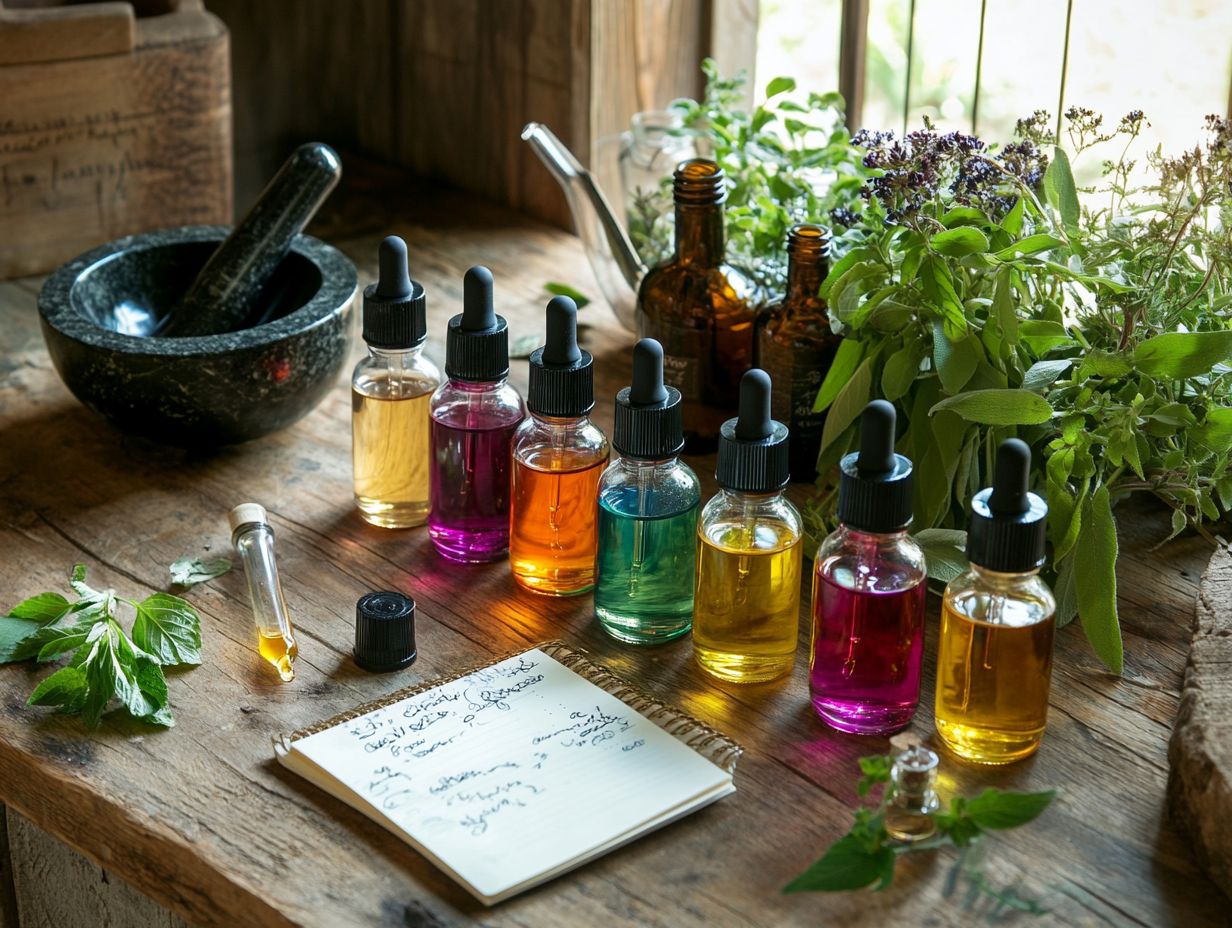
- Understand the benefits of herbal oils and how they can enhance your health and well-being.
- Select the right carrier oil and herbs for your desired results to create a personalized blend that works for you.
- Follow proper storage and preservation methods, and explore various ways to use herbal oils safely and effectively in your daily routine.
1. Understanding the Benefits of Herbal Oils
Herbal oils are becoming increasingly popular due to their many benefits, offering a natural option for skincare, cooking, and medicinal uses. You can craft your own herbal oil infusion by infusing dried and fresh herbs like chamomile, lavender, and calendula.
This popular method enhances the benefits of your creations, brimming with beneficial compounds that support your natural lifestyle. These homemade oils can be customized to address various needs, from soothing skin irritations to amplifying flavors in your culinary creations.
Utilizing these oils can lead to radiant skin, as many herbs like comfrey and Echinacea are rich in anti-inflammatory and antioxidant properties, promoting healing and rejuvenation.
In the kitchen, they transform dishes, drawing out complex flavors while providing a more nutritious profile than traditional oils, especially when using infused oils.
The art of crafting these infusions not only sparks your creativity but also ensures that you know the quality and source of each ingredient. This connection to nature and commitment to personal wellness resonates with those like you who seek a healthier, chemical-free lifestyle, creating a compelling allure for handmade herbal solutions.
2. Essential Tools and Ingredients for Making Herbal Oils
To create your own herbal oils, you ll need a few essential tools and ingredients. Start with a selection of dried herbs and fresh herbs, an appropriate carrier oil (the base oil that carries the herbal properties), and a reliable infusion method like the quick heat method or the cold infusion technique.
Having glass jars for storage and strainers for filtering the mixture will make the process much smoother. Options like jojoba oil and olive oil are critical; each offers distinct benefits and properties that elevate your final product.
Choosing the right herbs is equally vital; select them based on their intended use be it for aromatherapy, skin care, or culinary applications. By understanding the unique characteristics of each herb and oil, you can craft a one-of-a-kind blend tailored to your specific needs and preferences.
3. Choosing the Right Carrier Oil for Your Blend
Selecting the right carrier oil is essential for your herbal oil infusion, as it directly influences the texture, scent, and overall effectiveness of your blend.
The carrier oil you choose can significantly impact not just the sensory qualities but also the therapeutic benefits of your infusion. For example, jojoba oil closely mimics the skin’s natural sebum, making it a popular choice in herbal oils and essential oil blends. It is particularly effective for moisturizing and balancing oily skin types.
In contrast, olive oil is renowned for its rich antioxidants and is often the go-to choice for culinary infusions. It is a favorite for edible herbal blends and a key ingredient in many herbal oil infusion recipes.
By thoughtfully selecting a carrier oil that aligns with the properties of your chosen herbs, you can elevate the overall effectiveness of your infusion, creating a harmonious blend that works synergistically to achieve your desired outcomes.
4. Selecting the Best Herbs for Your Desired Results
Regarding crafting herbal oils, choosing the finest herbs is crucial for achieving the results you desire, whether for skin care or culinary applications.
Some popular choices include chamomile, celebrated for its soothing qualities, and lavender, which not only adds a delightful aroma but also aids in relaxation and skin healing. Calendula, with its anti-inflammatory properties, can be blended with other herbs to create powerful oils that address specific issues. By grasping the unique characteristics of each herb, you can formulate combinations that enhance their effectiveness.
For instance, a blend of lavender and chamomile can foster restful sleep, while pairing calendula with chamomile might work wonders for irritated skin. Adding a touch of peppermint can invigorate your blend. This showcases how crafting your own herbal remedies at home can meet a range of needs, tailored just for you.
5. Step-by-Step Guide to Making Your Own Herbal Oil Blend
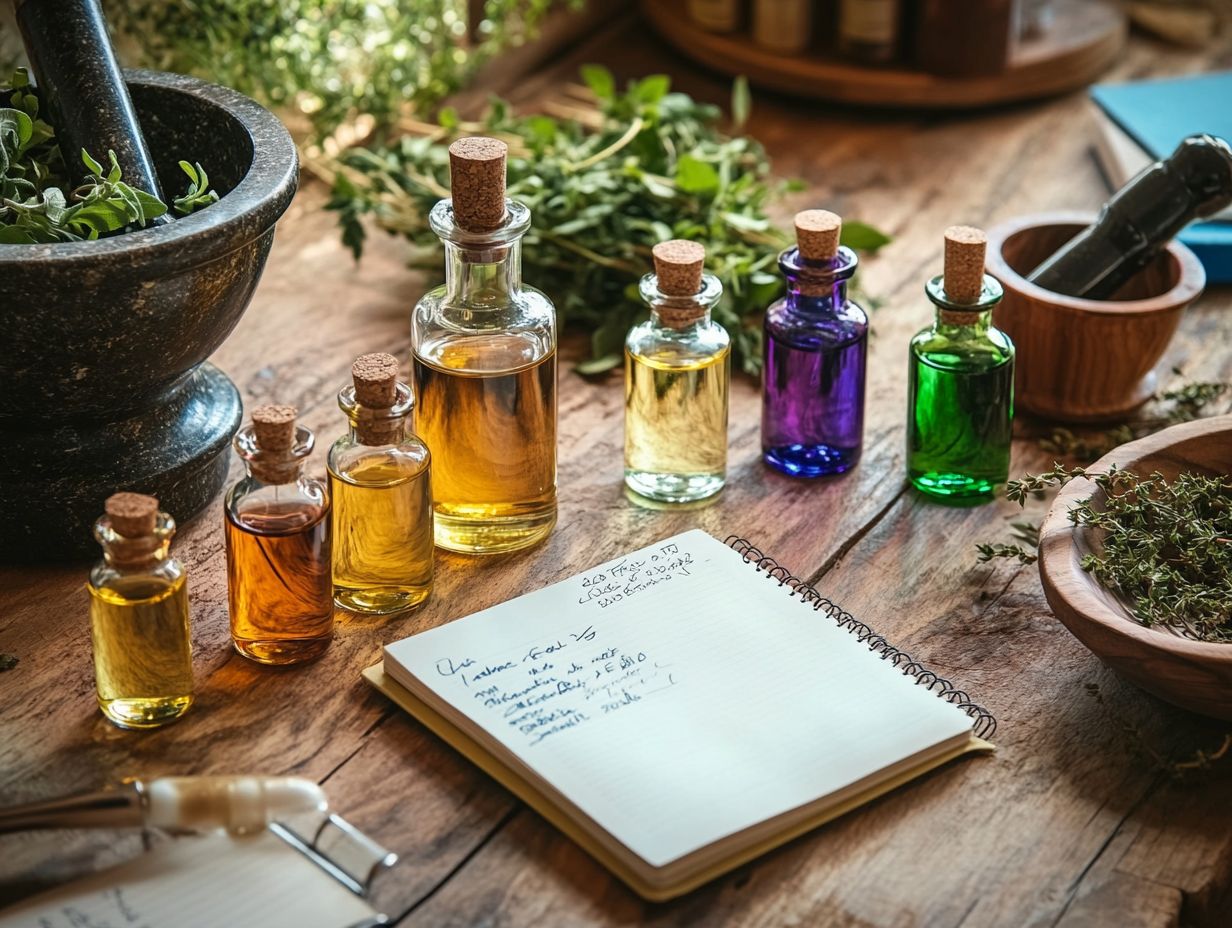
Making your own herbal oil blend is easy and fun! You can choose the quick heat method or the more patient cold infusion technique, both of which allow you to extract the full essence of your chosen herbs.
To begin, gather high-quality herbs and a suitable carrier oil, like olive or almond oil, which will serve as the foundation for your infusion. Preparation is essential; cut or crush the herbs to release their essential oils, maximizing both flavor and medicinal benefits. For more information, check out this guide on how to make herbal smoking blends.
If you opt for the heat method, gently warm the oil in a double boiler (a pot with two layers used for gentle heating) while adding the herbs, stirring occasionally to prevent any burning. On the other hand, the cold infusion method involves placing your herbs in a clean glass jar, covering them with oil, and allowing the mixture to steep in a cool, dark space for several weeks. This process results in a flavorful and aromatic infused oil.
Regardless of the technique you choose, remember to strain the infused oil using cheesecloth or a fine mesh strainer, and store the final product in dark glass bottles to preserve its effectiveness. This careful method captures the best flavor and medicinal properties of each herb, resulting in a beneficial oil.
6. Tips for Storing and Preserving Your Herbal Oils
Proper storage and preservation of your herbal oils, such as lavender and chamomile, are crucial for maintaining their effectiveness and extending their shelf life.
To achieve this, you should store them in cool, dark places, away from direct sunlight, as exposure to light and heat can degrade their quality over time. Use dark glass containers, such as amber or cobalt blue bottles, to block harmful UV rays. Always make sure the containers are tightly sealed to prevent oxidation.
Check your oils regularly for signs of spoilage. Stay vigilant for signs such as off-odors or changes in color and consistency. If you have oils with shorter shelf lives, refrigerating them can help maintain freshness. Regularly checking for any signs of rancidity ensures that each use remains a delightful experience.
7. Different Methods of Using Herbal Oils
Get ready to boost your wellness journey with these amazing oils! Herbal oils, including essential oils like tea tree oil, can be used in a multitude of ways, enhancing both your skincare routines and culinary creations with their distinctive flavors and benefits.
These versatile oils lavender, eucalyptus, and rosemary do more than just elevate the scent; they bring therapeutic properties that can turn everyday activities into mindful rituals. For example, you can easily incorporate lavender oil into a homemade moisturizer, promoting relaxation while keeping your skin beautifully hydrated.
Regarding cooking, infusing oils with herbs can take even the simplest dishes to new heights imagine drizzling rosemary-infused olive oil over roasted vegetables for a delightful burst of flavor.
Certain herbal oils, such as tea tree oil, offer antiseptic qualities, making them invaluable in natural remedies for minor skin irritations. By weaving these oils into your daily life, you not only enhance your experiences but also contribute to your overall well-being.
8. Safety Precautions to Keep in Mind
While herbal oils offer a wealth of benefits, it’s imperative to adhere to safety precautions to avoid adverse reactions or improper usage.
Be aware of the potential for allergic reactions, which can range from mild skin irritations to serious respiratory issues. Stay vigilant when incorporating these natural remedies into your daily routine.
Proper dilution is crucial; concentrated essential oils can cause harm if applied directly to the skin. Safe storage is essential to maintain the oils’ effectiveness and prevent contamination. Keeping them in a cool, dark place is your best bet.
Most importantly, consulting with a healthcare provider is a smart move to determine the suitability of these oils, especially for medical uses. This ensures that your experience is both safe and beneficial.
9. Common Mistakes to Avoid When Making Herbal Oils
Creating herbal oils can be a truly rewarding endeavor. However, be mindful of common mistakes that could compromise the quality of your infusion, such as using the wrong herbs or improper methods like not following the quick heat method accurately.
One major pitfall is choosing the wrong herbs; not every herb releases its beneficial properties effectively in oil. If the infusion times are incorrect, you might end up with an oil that lacks the essence of the plant.
Improper storage can cause spoilage or diminish potency. To avoid these pitfalls, select fresh, high-quality herbs and adhere to appropriate infusion times, typically ranging from two to six weeks, depending on the characteristics of the plant.
For storage, opt for dark glass bottles and keep them in a cool, dark place. This simple step can help maintain the integrity of your oil, ensuring those delightful herbal aromas and effects remain vibrant and effective.
10. How to Incorporate Herbal Oils into Your Daily Routine

Incorporating herbal oils into your daily routine can elevate your natural lifestyle, offering both health benefits and sensory delights.
These versatile oils blend easily into your skincare regimen, allowing you to create personalized moisturizers that nourish and rejuvenate your skin. Just picture this: a few drops of lavender or tea tree oil can transform your basic lotion into a soothing balm for your weary skin! For an added touch, consider exploring the art of herbal tea blending to complement your self-care routine!
In the kitchen, these oils act as vibrant flavor enhancers, elevating your dishes with their aromatic profiles while also providing potential health perks, like aiding digestion.
When it comes to aromatherapy, diffusing herbal oils such as eucalyptus or peppermint can create a relaxing environment, promoting relaxation and mental clarity. These practices enrich your daily routines and enable you to embrace a holistic approach to well-being.
11. DIY Herbal Oil Recipes for Different Purposes
Crafting your own DIY herbal oil recipes allows you to tailor your blends precisely to your needs, whether you seek relaxation, nourishment, or healing.
By integrating various herbs into your creations, you can harness their unique properties to enhance your well-being. Imagine feeling the calming effects of chamomile in a soothing massage oil perfect for unwinding after a long day. Or infusing lavender into a calming blend that encourages restful sleep and eases anxiety, as explored in herbal remedies in your kitchen.
Calendula, known for its skin-soothing qualities, makes an excellent ingredient for a nourishing body oil, especially if you’re dealing with dry or irritated skin. Each herb offers distinct advantages, inviting you to mix and match based on your preferences and desired outcomes, using dried herbs or fresh herbs as desired. If you’re interested in incorporating herbal ingredients into your routine, consider exploring how to make your own herbal tea at home.
Let your creativity flourish as you explore the endless possibilities in herbal oil crafting. Turn each blend into a personal masterpiece!
12. Combining Herbal Oils for Maximum Benefits
Combining different herbal oils allows you to create powerful essential oil blends that truly maximize the benefits of each ingredient.
By understanding the unique properties of various herbs, you can curate combinations that elevate their aromatic appeal and offer significant therapeutic advantages. For instance, lavender and chamomile work beautifully together to promote relaxation and reduce stress. Meanwhile, the invigorating properties of peppermint pair wonderfully with eucalyptus to clear the mind and support respiratory health.
Incorporating carrier oils like jojoba or sweet almond enriches these blends. This ensures a balanced texture for easy application on the skin. Experimentation is essential; starting with small batches can help you discover harmonious pairings that resonate with your preferences and desired outcomes. Additionally, exploring herbal remedies can further enhance your creations.
13. Understanding the Shelf Life of Herbal Oils
Understanding the shelf life of herbal oils is crucial for ensuring their effectiveness and safety over time, especially when using jojoba oil and olive oil as carriers.
Several factors influence how long these oils remain viable for use. The type of carrier oil plays a significant role in the oil’s longevity. For example, sweet almond and apricot kernel oils typically have shorter shelf lives, ranging from six months to a year. In contrast, jojoba and fractionated coconut oil can last for several years. The specific herbs infused in the oils also affect durability; some herbs, like rosemary, are naturally antimicrobial and help extend shelf life.
Proper storage is essential. Keep your oils in cool, dark places away from heat sources and light exposure to maximize their duration and maintain their therapeutic benefits.
14. How to Troubleshoot Common Issues with Herbal Oils
Troubleshooting common issues with herbal oils can refine your infusion process, leading to remarkable results.
You might find that your herbal oils lack the robust scent you desire. This often stems from insufficient steeping time or using dried herbs that have lost potency. If you notice unwanted separation in your oils, it may indicate an imbalance in the oil-to-herb ratio or even moisture in the mixture. To enhance your herbal preparations, consider learning how to make herbal balm at home. Such varying levels of potency can diminish the intended effects.
To combat these challenges, consider these approaches in your herbal oil infusion process:
- Extend the infusion period
- Use freshly harvested herbs
- Ensure a dry environment during preparation
By paying closer attention to the ratios and quality of your ingredients, including homemade products and essential oils, you can elevate your herbal oils to impressive new heights.
15. Final Thoughts: Experiment and Have Fun with Your Own Herbal Oil Blends
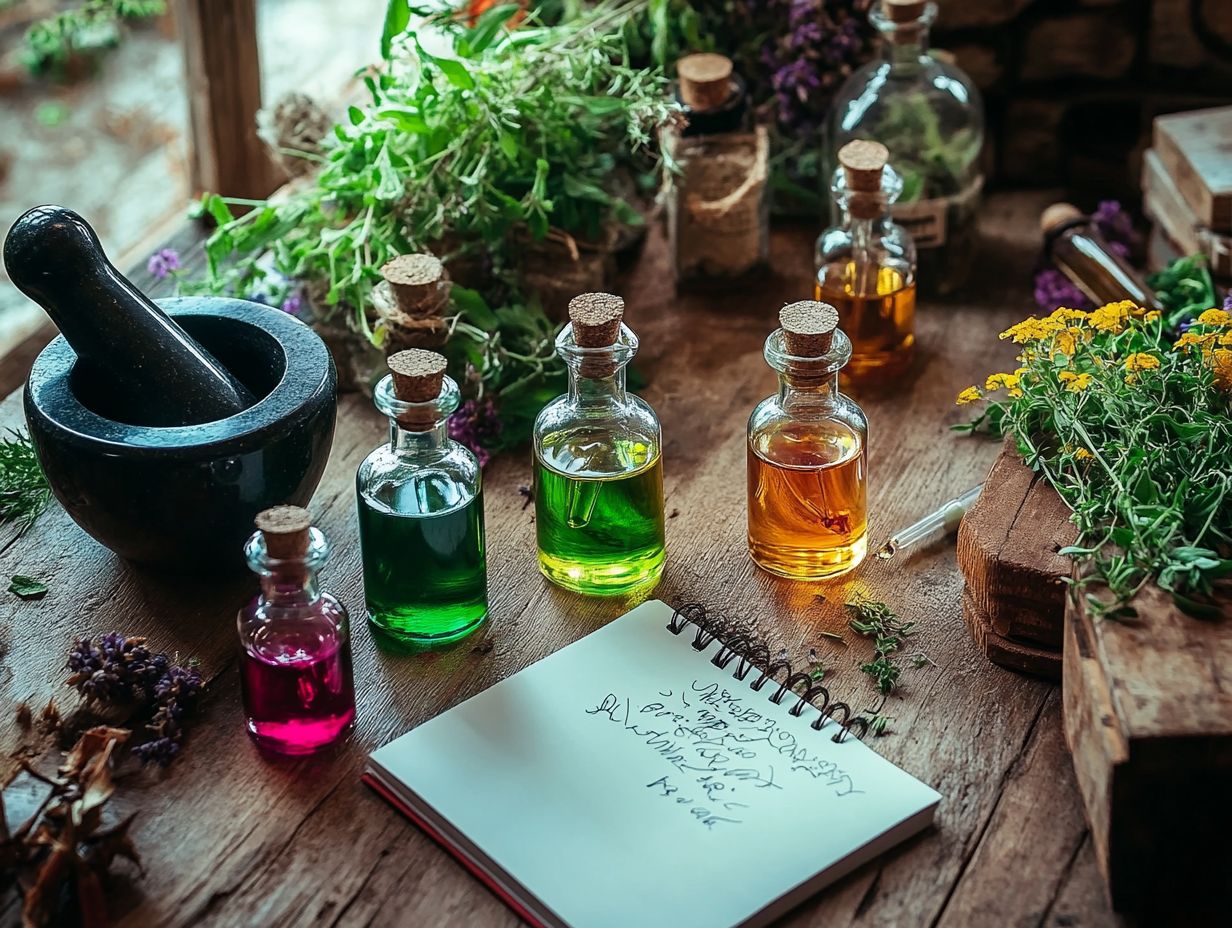
Experimenting with your own herbal oil blends can be an enjoyable and fulfilling journey. It enriches your natural lifestyle and well-being, giving you the chance to create unique homemade products.
By immersing yourself in the vast selection of herbs and carrier oils, you unlock a treasure trove of scents and benefits tailored to your unique needs. Imagine customizing blends that not only smell exquisite but also nourish your skin and uplift your mood! For a deeper dive into creating your own blends, check out homemade herbal salves: a quick guide. Whether you’re infusing calming lavender into a soothing balm or invigorating peppermint for a refreshing massage oil, the possibilities are endless.
As you explore this creative process, you ll appreciate nature s offerings more deeply. Celebrate your personal expression through the art of herbal crafting and discover the magic of essential oils!
Frequently Asked Questions
What are herbal oils and why should I make my own blends using infused oil techniques?
Herbal oils are oils infused with medicinal or aromatic herbs. Making your own blends allows you to customize the oils for your specific needs while ensuring the quality and purity of the ingredients.
What are some common herbs used in herbal oils?
Common herbs include chamomile, lavender, rosemary, calendula, and peppermint. Each of these herbs has unique benefits and can be mixed in different ratios for special blends.
How do I make my own herbal oil blends?
To create your own blends, mix your chosen herbs with a base oil like olive, almond, or jojoba. You can do this using the cold or heat mixing method.
Can I use fresh herbs, or should I dry them first?
You can use both fresh and dried herbs. However, dried herbs are better since they have less moisture, which minimizes bacteria growth in the oil.
How long does it take to make herbal oil blends?
The time varies by method and herbs. Cold mixing can take 2-4 weeks, while heat mixing usually takes 1-2 hours. Some herbs need longer for full potency.
How do I store and use my herbal oil blends?
Store your blends in a cool, dark place to keep them fresh. You can use them for massage, as a moisturizer, or add them to your bath. Always do a patch test before applying to a larger skin area.

